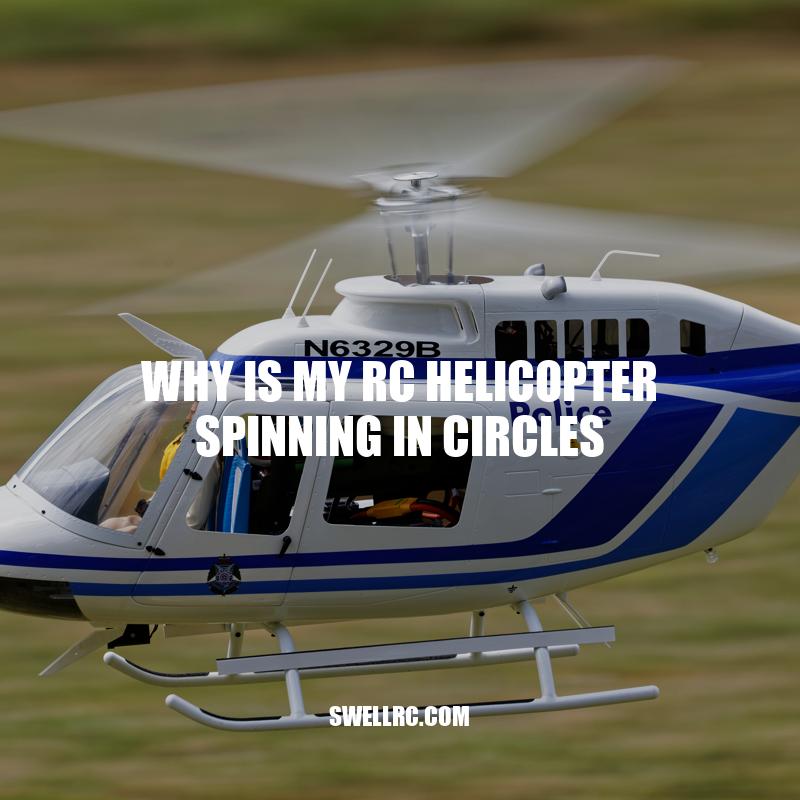Troubleshooting RC Helicopter Spinning: Causes and Fixes
Remote-controlled (RC) helicopters are popular among hobbyists of all ages, offering an exciting and rewarding experience. However, one of the most common issues people face while flying these miniature machines is the helicopter spinning in circles. This can be an incredibly frustrating problem that can take all the fun out of the hobby. If you’re experiencing this issue, identifying the cause is imperative to rectifying it. In this article, we will discuss why RC helicopters spin in circles, exploring the various factors that can contribute to this problem. By understanding the root cause of this issue, you can take steps to enjoy smooth and stable flights, and make the most out of your RC helicopter.
Uneven Rotor Blade or Unbalanced Helicopter
RC helicopters rely on the stability of their rotors to stay in the air. If the rotors are damaged or uneven, it can lead to a variety of problems, including spinning in circles. Some of the most common issues related to uneven rotors or an unbalanced helicopter include:
- Crash damage or wear and tear
- Inconsistent airflow
- Uneven weight distribution
If you suspect that an uneven rotor blade or an unbalanced helicopter is causing your RC helicopter to spin in circles, there are several things you can do to rectify the problem. One option is to replace any damaged or worn rotor blades with new ones. Another is to redistribute weight on the helicopter, maybe by attaching or detaching some parts. Look up tutorials on websites like dronefly or bigsquiddrc to better understand the process. In case the issue still persists, consult with the manufacturer or consider getting the helicopter serviced.
Is a helicopter balanced or unbalanced?
Helicopters are inherently unbalanced due to the unequal distribution of weight and upward thrust. However, they are designed to achieve balance in flight through the use of a swashplate and counter-rotating blades.
If you are interested in learning more about helicopters, there are many resources available online. Websites such as helicopterpage.com and rotor.org provide information on helicopter technology, safety, and education. Additionally, there are helicopter simulation software products available for those looking to experience virtual helicopter flight.
Incorrect Trim Settings
Another common cause of RC helicopters spinning in circles is incorrect trim settings. Trim settings can be thought of as fine adjustments made to an RC helicopter’s control surfaces that affect its stability and movement. Some things that can cause incorrect trim settings include:
- Misaligned body parts
- Uneven amounts of lift on each rotor
- An improperly centered center of gravity
If you think that your RC helicopter’s spin is caused by incorrect trim settings, you’ll want to adjust these settings as soon as possible. The best way to do this is to consult the owner’s manual for your specific RC helicopter model. You can also find helpful tutorials on websites like rcguides or rcgroups. Here’s a reference table for the recommended trim settings:
| RC Helicopter Model | Recommended Trim Settings |
|---|---|
| Blade 230 S | Set center of gravity at 60% |
| Synergy E5 | Center the swashplate to base drive gear |
| Holy Stone HS100D | Rotate the trim dial to its default position (centered) |
What causes helicopter to spin?
Helicopters can spin due to several reasons, including:
- Unequal lift or torque from the main rotors
- Unbalanced weight distribution
- Inappropriate use of the rudder pedals
- Wind gusts or turbulence
- Mechanical failure
If you are interested in learning more about helicopters and how they operate, you can visit websites such as Helicopter Association International or the Federal Aviation Administration. If you are in the market for a helicopter or helicopter-related products, you can check out companies like Bell Helicopter or Robinson Helicopter Company.
Gyro Issues
Your RC helicopter’s gyro helps it maintain stability and counteracts any movements that might cause it to spin. Unfortunately, issues with the gyro can also cause spinning to occur. Here are some common gyro issues:
- Gyro drift – this is when changes in temperature cause the gyro to generate incorrect readings.
- Resetting issues – if the gyro reverts to its factory settings, it can cause spinning issues.
- Hardware issues – if the gyro components are not properly secured to the helicopter, it can cause gyro issues.
To fix gyro issues, you could try the following:
- Check the wiring for any damage or looseness
- Check connections by plugging into a servo tester
- Reprogram the gyro (if supported)
- Replace the gyro (if other solutions do not work).
Additionally, you can search for specific solutions for your gyro’s make and model on websites such as RC Heli Nation or RC Hobby Review. Remember to always consult the manufacturer’s manual before attempting any repairs or replacements on your own.
What causes a gyroscope to continue spinning?
A gyroscope is a device that maintains its axis of rotation irrespective of any external force applied to it. Here are some reasons why it continues spinning:
- The conservation of angular momentum.
- The design of the gyroscope that helps in maintaining a state of equilibrium.
- Frictionless bearings that reduce the loss of energy due to friction.
For more information about gyroscopes and their applications, you can visit websites such as Explain That Stuff or products such as the Simple Gyroscope.
Environmental Factors
Environmental factors such as wind can also affect the stability of your RC helicopter and cause it to spin. Here are a few things to keep in mind:
- Check weather forecasts and avoid flying in high gusts of wind and turbulence
- Avoid flying near obstacles, buildings, or trees that can create wind tunnels and cause turbulence
- Choose a calm and clear day to fly outdoors
- Avoid flying on tall grass, as it can interfere with the rotor blades’ operation and cause uneven lift.
In addition to these tips, you may want to explore online forums and blogs where experienced RC helicopter enthusiasts share their experiences and troubleshooting tips. Websites such as RCGroups and Helifreak have active communities dedicated to RC helicopter flying and maintenance, where you can ask questions and seek advice on your spinning problems. Remember that flying an RC helicopter takes a lot of practice and patience, so don’t give up if you experience spinning issues in the beginning. With time and effort, you can master the art of flying your RC helicopter smoothly and with confidence.
What is it called when a helicopter spins?
When a helicopter spins on its vertical axis, it is called a yaw motion. This is caused by the tail rotor changing the direction of airflow and causing the helicopter to turn. It can also be referred to as a pirouette.
If you’re interested in learning more about helicopters, there are several websites and products available:
- Vertical Magazine covers news and information specifically for the helicopter industry.
- Helicopter Association International is a membership organization for those in the helicopter industry with resources and events available.
- Helicopters: Amazing Machines by Penny Dale is an informative children’s book about the science and mechanics behind helicopters.
Pilot Error
Another common cause of spinning in RC helicopters is pilot error. Here are some tips to avoid spinning due to piloting mistakes:
- Practice your hovering and control skills in a simulator or with a less expensive RC helicopter before investing in a more advanced model
- Avoid sudden or jerky movements and inputs that can throw off the balance of your RC helicopter
- Be gentle on the control sticks and avoid over-correction
- Pay attention to the orientation of your helicopter and avoid confusing the front and back or left and right controls
If you are still experiencing spinning issues due to piloting mistakes, you may want to consider attending an RC helicopter flying workshop or joining a local club. Flying with experienced pilots can help you improve your skills and troubleshoot your spinning issues more effectively.
In addition, some RC helicopter models come with built-in stability features and auto-leveling technology, which can make it easier for beginner pilots to avoid spinning and stay in control. Consider researching and investing in a beginner-friendly model if you are just starting out.
Remember that as a pilot, your skills and experience play a significant role in the performance of your RC helicopter. By practicing and improving your flying technique, you can minimize and eventually eliminate spinning issues and enjoy a smooth, stable flight every time.
Why does my RC helicopter keep spinning?
There are several reasons why your RC helicopter keeps spinning, such as:
- Uneven weight distribution
- Corrupted gyro sensor
- Malfunctioning motors
- Incorrect blade settings
To troubleshoot the problem, try recalibrating the gyro sensor or adjusting the blade settings. If the issue persists, consider seeking professional help or referring to the manufacturer’s website for further assistance.
Conclusion
Spinning in circles is a common issue that RC helicopter pilots encounter, but it’s not an unsolvable problem. By identifying the cause of the spinning and taking the appropriate steps to address it, you can enjoy a stable and balanced RC helicopter flight. As we have discussed, the potential causes of spinning are numerous, ranging from mechanical problems to environments and pilot error. When experiencing this problem, it’s crucial to troubleshoot and figure out what is causing it, before anything else. With the tips we’ve provided for each potential cause of spinning, you can learn to fix your helicopter and get back in the air, free of spinning issues.
Products and Services
When experiencing spinning problems, you can find help from various products and services, like:
- RC helicopter manuals and guides
- RC helicopter forums and online communities
- Online tutorials and videos that cover techniques and tips when flying RC helicopters
- Tech support from manufacturers
Continue to Learn and Improve Your Skills
Remember, RC helicopter flying is a fun and rewarding hobby that requires time, patience, and practice to master. By continuing to improve your skills as a pilot and troubleshooter, you can enjoy a more stable and rewarding flight experience.



